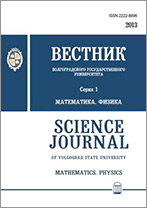|
|
Vestnik Volgogradskogo gosudarstvennogo universiteta. Seriya 1. Mathematica. Physica, 2014, Issue 1(20), Pages 61–68
(Mi vvgum16)
|
 |
|
 |
Astrophysics
Dynamic modeling for estimating the Galactic mass halo according to new data of the masers kinematics
M. A. Butenko, A. V. Khoperskov
Volgograd State University
Abstract:
Observational data on the kinematics of the masers with measured trigonometric parallaxes lead to a revision of the quantitative parameters of our Galaxy rotation curve. In particular, the rotation velocity $ V $ near of the Sun, apparently, more than $250$ km/s for the distance to the galactic center $ R = 8-8.5$ kpc. The choice of velocity $V$ and radius $R$ values influences on decomposition of gravitational potential on the main subsystems' result. In particular, there is a problem of specification of the main galactic components' masses — disk and dark halo. The masers kinematics data of the bulge and bar parameters, and vertical structure of the stellar disk were also used. The series of the Galaxys dynamical models are constructed assuming that the entire disk is near the gravitational-stability limit. On the basis of these models have been new estimates of the dark halo mass at different distances from the galaxy center within the radius of $12$ kpc.
Estimate mass values obtained with observational data of masers give the following results. Inside radius $ r <12 $ kpc relative mass of the halo is $\mu (r) = M_h (r) / M_d = 2$, which is $25\%$ higher than the previously obtained value of the coefficient $\mu = 1.6$. Accordingly the observed distributions of dispersions stars velocities obtained in models with the values of the surface density in the solar neighborhood $66 M_\odot /$pc$^2$, the total mass of a disk thus doesn't exceed $\times 10^{10}$ of $M_\odot 5$.
Keywords:
Galaxy, Milky Way, rotation curve, masers, $N$-body simulation.
Citation:
M. A. Butenko, A. V. Khoperskov, “Dynamic modeling for estimating the Galactic mass halo according to new data of the masers kinematics”, Vestnik Volgogradskogo gosudarstvennogo universiteta. Seriya 1. Mathematica. Physica, 2014, no. 1(20), 61–68
Linking options:
https://www.mathnet.ru/eng/vvgum16 https://www.mathnet.ru/eng/vvgum/y2014/i1/p61
|

|




 Contact us:
Contact us: Terms of Use
Terms of Use
 Registration to the website
Registration to the website Logotypes
Logotypes








 Citation in format
Citation in format 